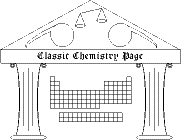Rutherford half life
Rutherford studied the radioactivity of "thorium emanation." This radioactivity was short-lived, decaying over the course of just a few minutes. He measured the strength of the activity by measuring the electrical current between two charged plates; radioactive substances ionize the air between the plates, inducing currents that would otherwise be absent. He reported the following data for current as a function of time.
TABLE III
Potential Difference 100 volts
|
| Time (s) | Current (relative)
|
| 0 | 1.00
|
| 28 | 0.69
|
| 62 | 0.51
|
| 118 | 0.23
|
| 155 | 0.14
|
| 210 | 0.067
|
| 272 | 0.041
|
| 360 | 0.018
|
(Download these data as a spreadsheet file by clicking here.)
1) Let us attempt to determine the kinetic order of the decay by making various plots of the data. If the process is zero-order, then a plot of the current vs. time would be a straight line; if the process is first-order, then a plot of the natural log of the current vs. time would be a straight line; and if the process is second-order, then a plot of the reciprocal of the current vs. time would be a straight line. Keeping in mind that the order need not be 0, 1, or 2, and that the plots may or may not show a clear result, make zero-order, first-order, and second-order plots and state the order if possible.
2) Approximately how long does it take for the current to drop to half of its initial value? (This is called the half life.) How long to drop from half to 1/4 (i.e., by half again)? From 0.30 to 0.15? If these times are about the same, then the half-life is constant; that is, the time it takes the current to drop to half its value is the same no matter what the initial value.
Reference
Ernest Rutherford, "A Radioactive Substance emitted from Thorium Compounds," Philosophical Magazine 49, 1-14 (1900).
Copyright 2003 by Carmen Giunta. Permission is granted to reproduce for non-commercial educational purposes.

| Back to the top of the Classic Chemistry site |